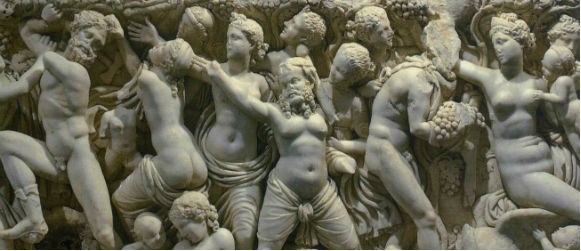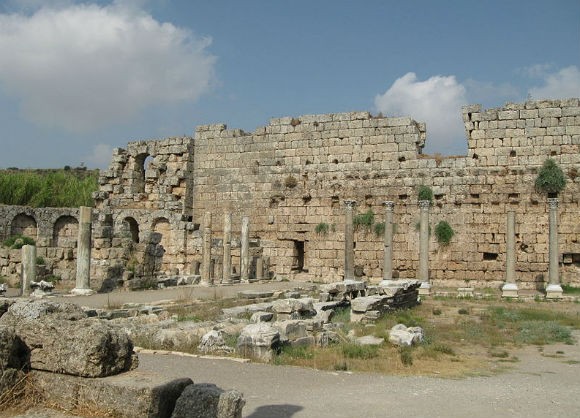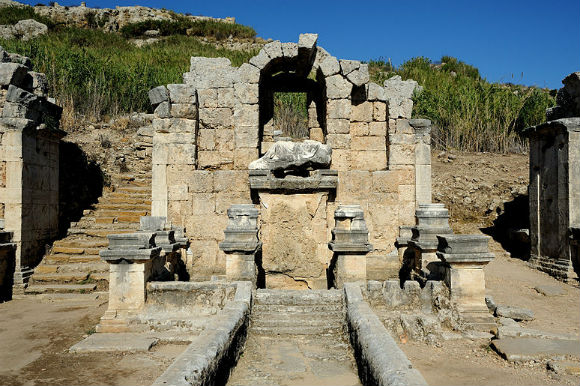Perga was an old city even in the first century. Its name (which is not Greek) indicates that its origin dates from pre-Greek times. Alexander the Great passed through it twice while the Pergaeans offered no resistance to him although it was a walled city with a citadel. In Roman times the main streets were over twenty-one meters wide. They were lined with Ionic colonnades and a water channel ran down their center in a series of small waterfalls as in Antalya today. Behind the colonnades stood the shops. Of the early buildings the stadium and the theater have survived the ravages of earthquakes and wars with the least damage. In fact this stadium which could seat about fourteen thousand people is one of the best preserved in Turkey.
The temple of the Pergaean Artemis according to a writer of the time was “a marvel of size, beauty, and workmanship.” Its location has yet to be established; it may have been where there are now ruins of a Byzantine church on a hill to the southeast of the city.
Perga is on a rise not far from the Cestrus River which was navigable In Paul’s time. It was not a seaport in terms of Its being directly on the Mediterranean even then, but rather it was more easily defended where it was: its distance from the open sea made it less vulnerable to piracy.
Two people stand out among the early residents of Perga. Apollonius was a third century B.C. astronomer and mathematician who believed that the movements of heavenly bodies in the universe were explainable by orbits within orbits: that the moon went around the earth as the earth went around the sun. He was much ahead of his time in his theories of astronomy, so much so that the ideas had to be rediscovered during the Renaissance. Plancia Magna was unusual for a second century A.D. woman: she held the highest city office during her life, that of demiurgus. She must have been well-to-do for a number of inscriptions record her gifts to the city.
Paul and Barnabas went through Perga on their way to and from Antioch on their first journey (Acts 13:13, 14:25). John Mark was with them at first but left them at Perga to return to Jerusalem. The reason for that must have been such that Paul doubted his commitment to the cause. Later when Paul and Barnabas were about to start on their second journey from Antioch they had a sharp dispute over his worthiness. Paul refused to have him go along, so John and Barnabas went to Cyprus while Paul chose Silas to accompany him.
Paul talks in II Corinthians 12:7 and in Galatians 4:13-14 of bodily illness that brought him to Galatia the first time. It may have been on that account that he did not stay long in Perga the first time. Whatever the illness was, it seems to have improved in time in the dry mountain air to the north.
The second theory of why they did not stay long in Perga is that their interview with Sergius Paulus, the proconsul of Cyprus, had made them want to hurry to the Roman colony in Antioch of Pisidia. This interpretation may lay too much stress on the lasting importance of that meeting with a cultured Roman who could have been more interested in the pursuits of the mind than the salvation, in Christian terms, of his soul. It is interesting, however, that this is” the point in Acts (13:9) that Luke begins to call Paul by his Roman name, not his Jewish “Saul”.
On their return they did stay in Perga long enough to preach and talk with people there. Nothing else is told about the city or their time there.
Perga,






Perge is easy to reach from Antalya & the surrounding resorts like Lara beach. Plenty to see & the trip is much enhanced by having a good guide to explain what you are seeing. The towers are unusual & the baths are impressive, but the whole site full of interest. Perge is famous by the fact that when Saint Paul…
world-famous ancient Greco-Roman theater of Aspendos, Perge, was one of the most important and beautiful ancient cities along the coast we were told. The apostle St.Paul preached here during his missionary journey and Perge is also known for being the birthplace of the famous mathematician Apollonius. We saw the ruins of the antique theater capacity for an audience of 12,000…
Wear hiking boots or shoes with thick soles for this walking trip. Not recommendated for people who are not used to walk on uneven, rugged ground.
This ruin had a different feel than Pompeii in Rome though both are Roman ruins.
Well worth seeing. But don't miss Pharselus, as that is probably even better. Abandoned Greek town to the S.W. Olympus is good for a laugh too – it has been taken over by a hippy commune.
One of best preserved ancient cities with 2000+ year old history just outside Antalya. It has everything: Stadium, Theatre, Baths, Agora, which is my favourite.
We visited last year and were greatly impressed with what you can see but this year it was even better. A lot of restoration work has been carried out so more to see. Little shelter from the sun though so wear a hat and take plenty of water because it is a big site to see. Has one of the…
The walking areas are not for disabled people. The restauration work was impressive and there much to do in the future. Entrance 6 TL
This big Roman ruin city is comparable to Efesos and is still under excavation, so it grows by the day. Lots of daytrips go here, and it was perhaps the cultural highlight of our week in Antalya. Book a guided trip and experience it!
We spent a lovely, sunny, and warm afternoon going round the great ruins of the city of Perga. Most satisfying exploration of a Greek-Roman ancient city. It was great to visit the site in November as there were only a few people coming at the same time and the weather was just perfect for such an activity.
This is a large site, with a number of structures still standing, including a magnicient entrance. The bath area is large and well preserved. As you walk the agora area you can almost hear the hawkers calling our inviting you into their businesses.